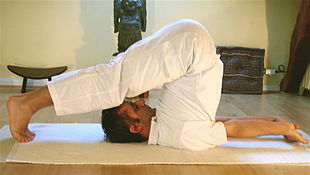Halasana
Appearance

Template:Contains Indic text Halasana (/hʌˈlæsʌnə/;[1] Sanskrit: हलासन; IAST: Halāsana) or Plough Pose[2] is an asana.
Etymology
The name comes from the Sanskrit words 'hala' (हला) meaning "plow" and 'asana' (आसन) meaning "posture" or "seat".[3]
Health benefits
- Stretches all muscles and ligament in the practitioner's calves and thighs, resulting in greater leg flexibility
- Therapeutic for leg cramps
- Stimulates the practitioner's thyroid, parathyroid, throat, lungs and abdominal organs
- Helps relieve gas and upper/lower back pain or discomfort
- Promotes good digestion
- Stretches the practitioner's shoulders and spine
- Therapeutic for menopause, infertility, insomnia, headache and sinusitis
- Relieves stress and fatigue [4][unreliable source?]
Cautions
This asana can put significant strain on the cervical spine, which does not normally undergo this type of stress, and can cause injury if not performed properly.[5][6][7]
See also
References
- ^ Budilovsky, Joan; Adamson, Eve (2000). The complete idiot's guide to yoga (2 ed.). Penguin. p. 175. ISBN 978-0-02-863970-3. Retrieved 11 April 2011.
- ^ "Yoga Journal - Plow Pose". Retrieved 2011-04-09.
- ^ Sivananda (Swami.) (June 1985). Health and hatha yoga. Divine Life Society. p. 128. ISBN 978-0-949027-03-0. Retrieved 9 April 2011.
- ^ http://www.cnyhealingarts.com/2011/07/13/the-health-benefits-of-halasana-plow-pose/
- ^ Active Interest Media, Inc. (February 1983). Yoga Journal. Active Interest Media, Inc. p. 7. ISSN 0191-0965. Retrieved 9 April 2011.
- ^ Robin, Mel (May 2002). A Physiological Handbook for Teachers of Yogasana. Wheatmark, Inc. p. 516. ISBN 978-1-58736-033-6. Retrieved 9 April 2011.
- ^ Robin, Mel (2009). A Handbook for Yogasana Teachers: The Incorporation of Neuroscience, Physiology, and Anatomy Into the Practice. Wheatmark, Inc. p. 835. ISBN 978-1-58736-708-3. Retrieved 9 April 2011.
Further reading
- Iyengar, B. K. S. (1 October 2005). Illustrated Light On Yoga. HarperCollins. ISBN 978-81-7223-606-9. Retrieved 9 April 2011.
- Saraswati, Swami Satyananda (1 August 2003). Asana Pranayama Mudra Bandha. Nesma Books India. ISBN 978-81-86336-14-4. Retrieved 9 April 2011.
- Saraswati, Swami Satyananda (January 2004). A Systematic Course in the Ancient Tantric Techniques of Yoga and Kriya. Nesma Books India. ISBN 978-81-85787-08-4. Retrieved 9 April 2011.

